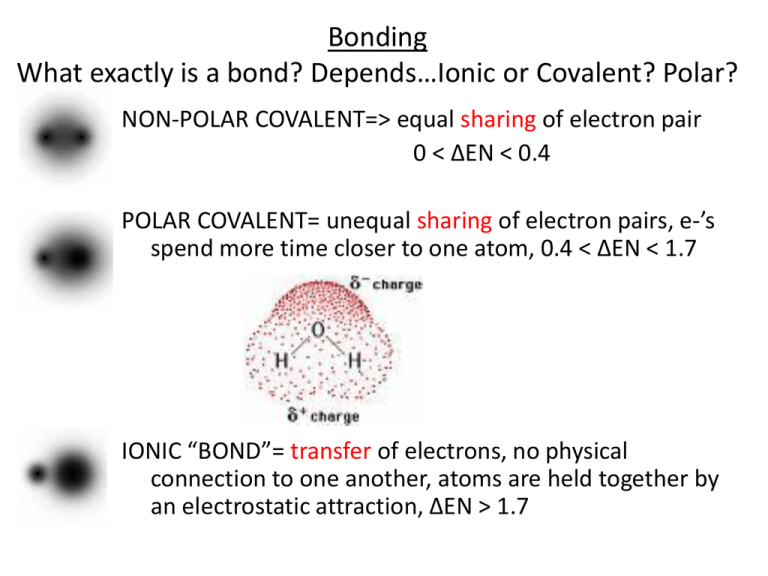Bonding What exactly is a bond? Depends…Ionic or Covalent? Polar?
advertisement

Bonding What exactly is a bond? Depends…Ionic or Covalent? Polar? NON-POLAR COVALENT=> equal sharing of electron pair 0 < ∆EN < 0.4 POLAR COVALENT= unequal sharing of electron pairs, e-’s spend more time closer to one atom, 0.4 < ∆EN < 1.7 IONIC “BOND”= transfer of electrons, no physical connection to one another, atoms are held together by an electrostatic attraction, ∆EN > 1.7 Molecular Polarity • • • • Tutorial 1: p. 226 Figure 6: p. 228 p. 227 #1,2 HW: p. 229 #1-7ab No molecular dipole => non-polar molecule Molecular Dipole is present => molecule No polar molecular dipole => non-polar molecule Molecular Dipole is present => polar molecule Which process requires more energy? Why? H2O(l) H2O(g) or 2 H2O(l) 2 H2(g) + O2(g) Intermolecular Forces London force (dispersion) •due to electrostatic attraction b/w protons in one molecule and electrons of neighbouring molecules •strength α # of e- Intermolecular Forces dipole-dipole force •due to attraction of one dipole by surrounding dipoles •strength α molecular polarity Intermolecular Forces Hydrogen bonding •due to attraction of a H bonded to a highly EN atom (O, N or F) in one molecule by the lone pair of e- on a highly electronegative atom of a neighbouring molecule H2Te H2Se H2S H2O bp = -10°C bp = -50°C bp = -80°C bp = 100°C List all IMF for each substance. • • • • • O2(g) Cl2O(g) H2O(l) CH4(g) CH3Cl(g) Arrange from lowest to highest bp. • • • • • • • H2O CH4 CH3Cl NH3 CH3OH H2 C3H8 Explain each statement. • Water has a much higher bp than methane. • Bromine is a liquid at room temperature while chlorine is a gas. • CHCl3 has a higher bp than CCl4. Properties of Ionic and Molecular Compounds Create a table to compare the following properties of ionic and molecular compounds. (p. 69) • state • solubility in water • electrical conductivity as a solid • electrical conductivity in aqueous solution • melting point • boiling point Intermolecular Forces and States Melting/Boiling Point Solubility in Water Low Conductivity of Covalent Compounds What is conductivity? What is electricity? Are the e- free to move in covalent bonds? Why or why not? Covalent compounds include fats and oils Which elements form covalent bonds? Do these usually conduct electricity? Conductivity of Ionic Compounds Is there an actual bond between ionic compounds? Ionic compounds are held together by electrostatic attractions The lack of physical bonds between ions means that electricity can be conducted through ionic compounds What types of elements form ionic compounds? Do these elements usually conduct electricity? Properties of Liquids Cohesive forces: • attractions b/w like molecules Adhesive forces: • attractions b/w unlike molecules Extra Practice for the Unit Test • There are Self-Quizzes at the end of each chapter and unit which provide further practice of concepts. Answers are provided in the back of the text book. For this unit, try Chapters 1-3 and Unit 1 SelfQuizzes. • Unit 1 Review p. 138 #4,6-16,18-20,22,23,25,26,2831,34-42,46-50,54-56,58,62-66,71-74




